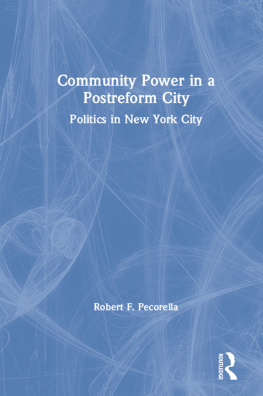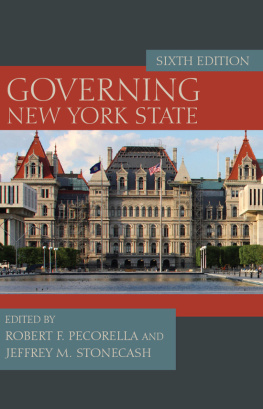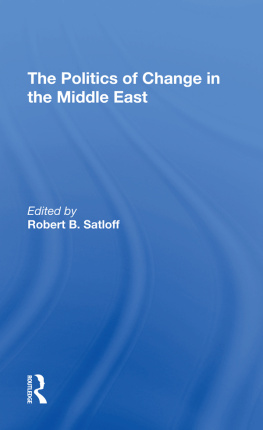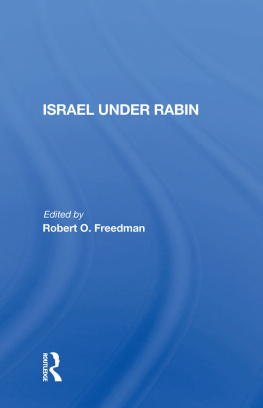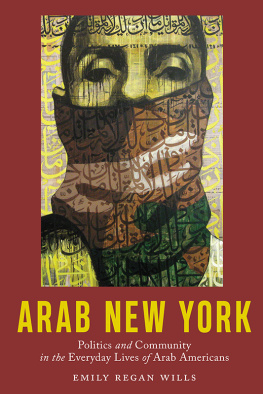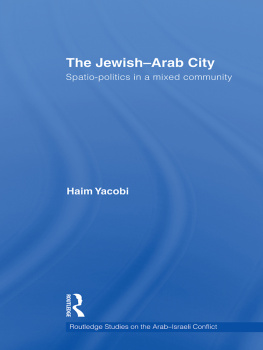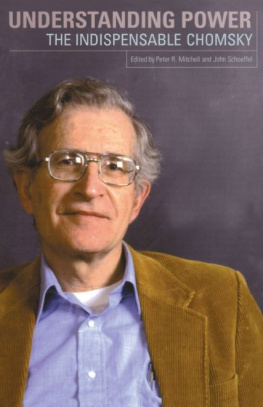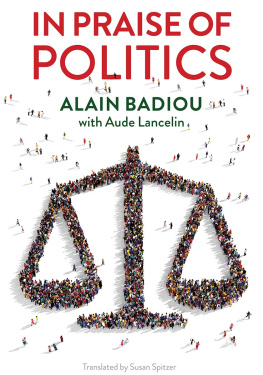COMMUNITY POWER IN A POSTREFORM CITY
COMMUNITY POWER IN A POSTREFORM CITY
Politics in New York City
ROBERT F. PECORELLA
First published 1994 by M.E. Sharpe
Published 2015 by Routledge
2 Park Square, Milton Park, Abingdon, Oxon OX14 4RN
711 Third Avenue, New York, NY 10017, USA
Routledge is an imprint of the Taylor & Francis Group, an informa business
Copyright 1994 Taylor & Francis. All rights reserved.
No part of this book may be reprinted or reproduced or utilised in any form or by any electronic, mechanical, or other means, now known or hereafter invented, including photocopying and recording, or in any information storage or retrieval system, without permission in writing from the publishers.
Notices
No responsibility is assumed by the publisher for any injury and/or damage to persons or property as a matter of products liability, negligence or otherwise, or from any use of operation of any methods, products, instructions or ideas contained in the material herein.
Practitioners and researchers must always rely on their own experience and knowledge in evaluating and using any information, methods, compounds, or experiments described herein. In using such information or methods they should be mindful of their own safety and the safety of others, including parties for whom they have a professional responsibility.
Product or corporate names may be trademarks or registered trademarks, and are used only for identification and explanation without intent to infringe.
Library of Congress Cataloging-in-Publication Data
Pecorella, Robert F., 1948
Community power in a postreform city:
politics in New York City
p. cm.Includes bibliographical references and index.
ISBN 1-56324-136-6
1. New York (N.Y.)Politics and government1951
2. Neighborhood governmentNew York (N.Y.)
I. Title.
JS1228.P431993
320.85097471dc20
93-22409
CIP
ISBN 13: 9781563241369 (hbk)
For Melody, who smiles knowingly.
CONTENTS
Chapter One
INTRODUCTION: FISCAL CRISIS, REGIME CHANGE, AND POLITICAL LEGITIMACY
Chapter Two
COMMUNITY POLITICS IN CONTEXT: MACHINE AND REFORM GOVERNANCE
Chapter Three
POSTREFORM POLITICS: THE REEMERGENCE OF COMMUNITY
Chapter Four
REFORM CONSOLIDATION AND THE POSTREFORM REACTION IN NEW YORK
Chapter Five
INSTITUTIONALIZING POSTREFORM: FISCAL CONTROL AND DECENTRALIZATION
Chapter Six
EVALUATING COMMUNITY BOARD EFFECTIVENESS
Chapter Seven
POSTREFORM AND COMMUNITY ACTIVISTS
Chapter Eight
SUMMARY AND CONCLUSIONS
This book represents the culmination of several years of research on community politics in New York City. It could not have been completed without the assistance of several groups of people. First, colleagues with whom I discussed the research helped me immeasurably. Their comments, suggestions, and arguments made the finished product more interesting and ultimately more satisfying. In this regard, I am particularly grateful to Bob Bailey from Columbia University, Doug Muzzio from Baruch College, Joe Viteritti from the Wagner Graduate School at New York University, and Ed Rogowsky from Brooklyn College. I also wish to acknowledge Clarence Stone from the University of Maryland, whose positive reactions to an earlier version of gave me confidence in the overall model.
I am also grateful to all the community board members from around the city who took the time to fill out and return the questionnaires, to the representatives of the borough community relations offices who spoke with me about the board system, to the officials at the Department of City Planning who helped clarify land-use issues, particularly ULURP, and to the officials at the Office of Community Board Relations at the New York City Office of Management and the Budget, whose courtesy and assistance made the somewhat tedious task of coding some two thousand community board budget proposals more tolerable. I also wish to acknowledge the American Political Science Association, whose small-grant program helped defray some of the costs involved in preparing and sending out the board members questionnaires. I also extend special words of thanks to Kelly Ronayne, whose patience and care in reviewing and proofreading the manuscript was of great assistance, and to Eileen M. Gaffney, whose careful copyediting was greatly appreciated.
Needless to say, all errors of fact, misinterpretations of information, or lack of clarity in the presentation are my own and I take full responsibility for them.
Finally, I want to acknowledge my spouse and other household friends without whom the book would have been finished sooner but with much less joy.
COMMUNITY POWER IN A POSTREFORM CITY
Although the assertion that New York City politics is crisis-driven is an exaggerated description of day-to-day life in the nations largest city, it nevertheless serves as a precise, analytical observation. This chapter presents a contextual approach to urban politics that suggests that periodic fiscal crises have resulted in regime changes in New Yorks governance. The approach provides a historical perspective to city politics from the machine era through the reform era as well as a method for analyzing New Yorks current postreform regime within its larger context. That postreform regime is characterized by a large welfare state under extragovernmental fiscal control coupled with the nations most ambitious attempt at urban decentralization, New Yorks community board system.
The contextual approach considers periods of both crisis and normal politics in New York. Crisis politics occurs when credit markets close to city debt; normal politics occurs the remainder of the time. Normal politics is characterized by the sometimes structured, sometimes informal, political interactions between government officials and private-sector members of the current governing coalition. It is these interactions that define regime politics. A regime thus involves not just any informal group that comes together to make a decision but an informal yet relatively stable group with access to institutional resources that enable it to have a sustained role in making governing decisions (Stone 1989, 239). Historically, political interactions with government officials have been more direct for some members of the coalition than for others. For some, interactions take place on a one-to-one basis; for others, they are channeled through mediating mechanisms such as elections and group activity.
Although periods of normal politics are, by definition, more frequent and long-lasting than periods of crisis, their relevant political interactions are defined by periods of crisis. Fiscal crises and retrenchment politics redefine normal politics by replacing one governing coalition with another and by changing the rules governing political behavior. As a result, both the process of supporting economic growth, necessary for fiscal health, and the process of democratic governance, necessary for political stability, change dramatically in the wake of fiscal crisis. Each new regime is characterized by a new coalition of political winners, some with direct access and others with indirect access to officials.

